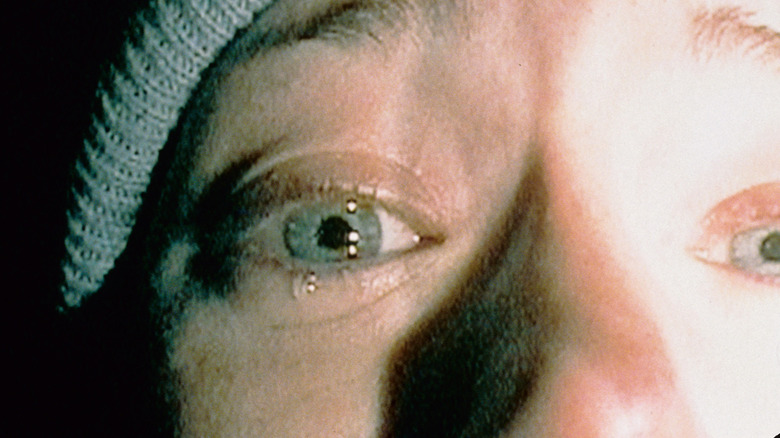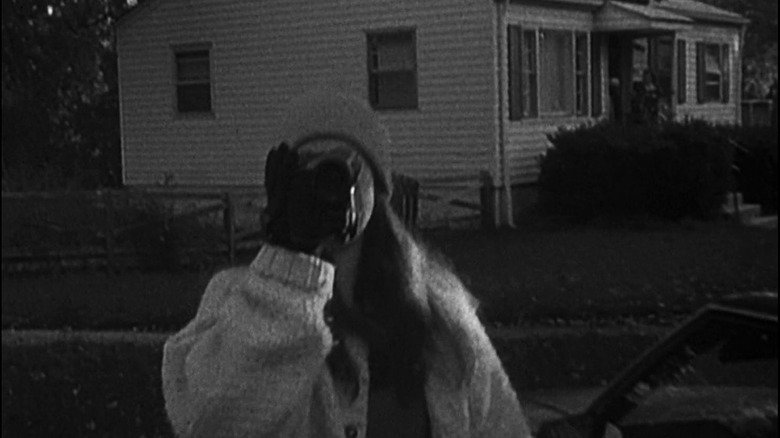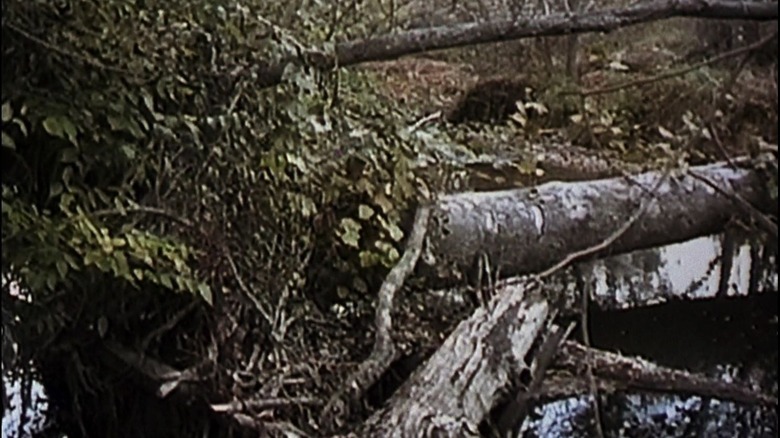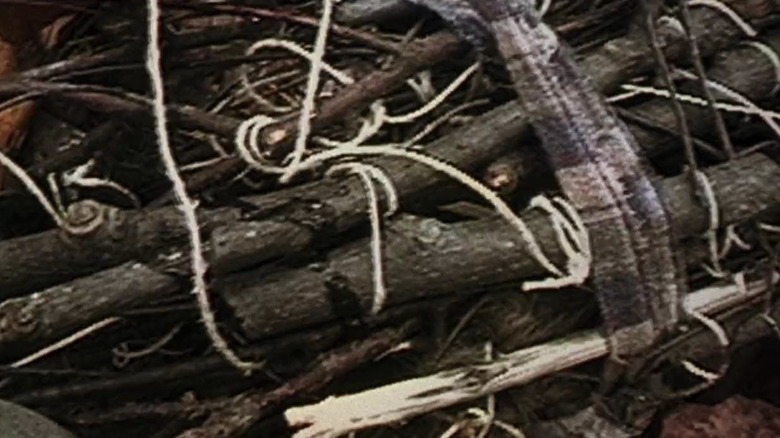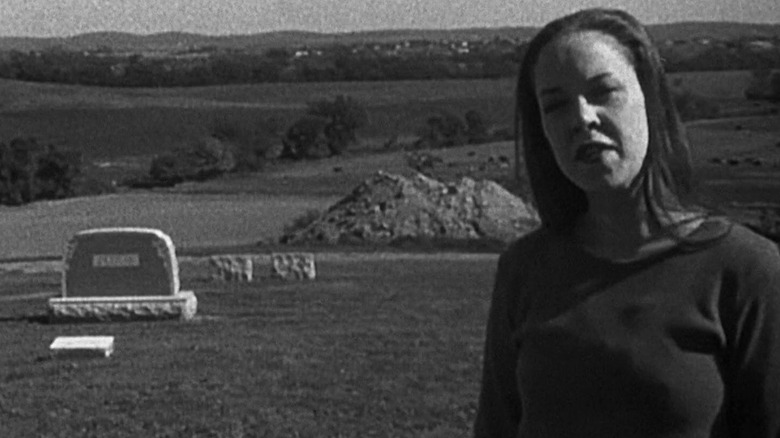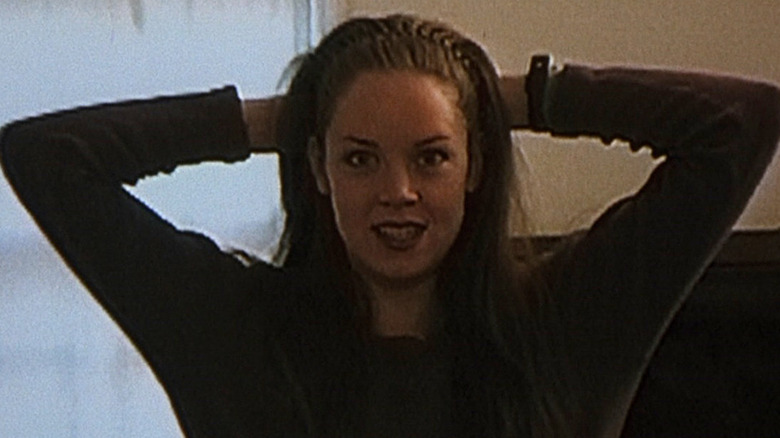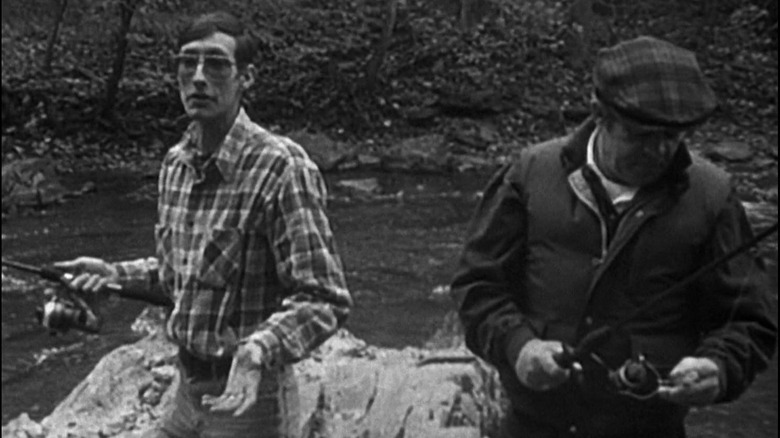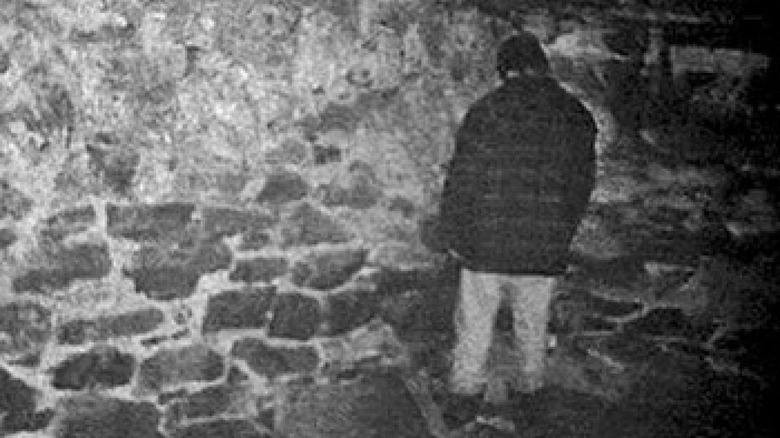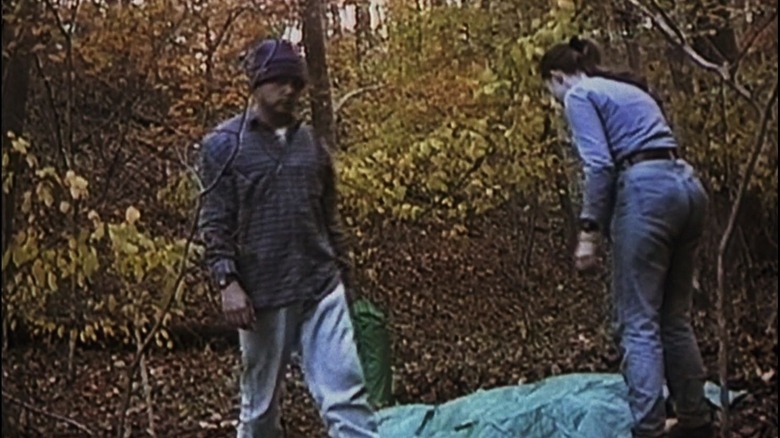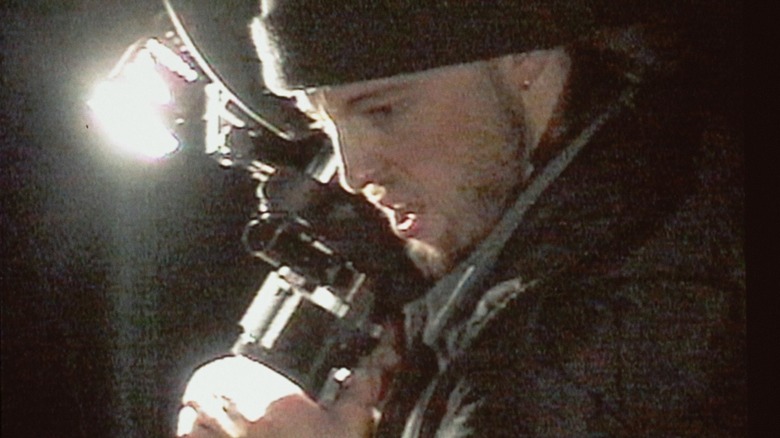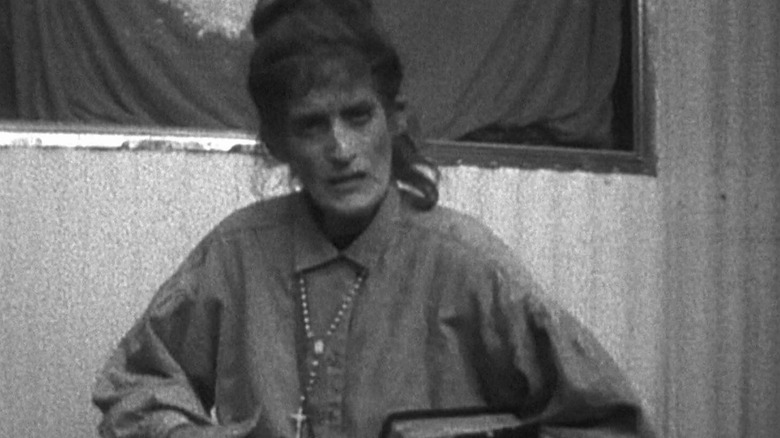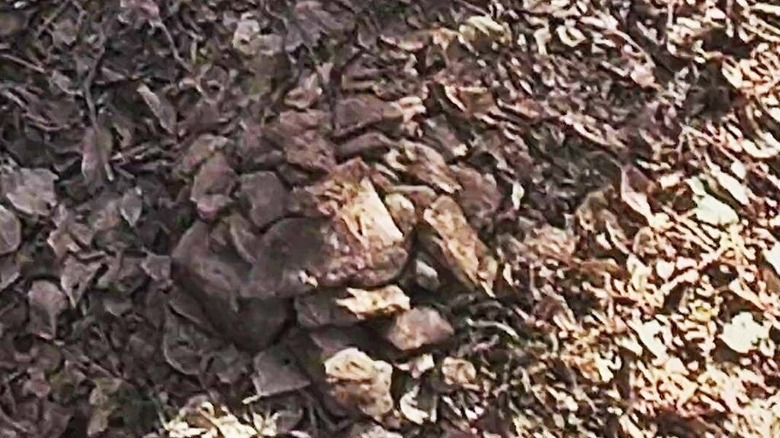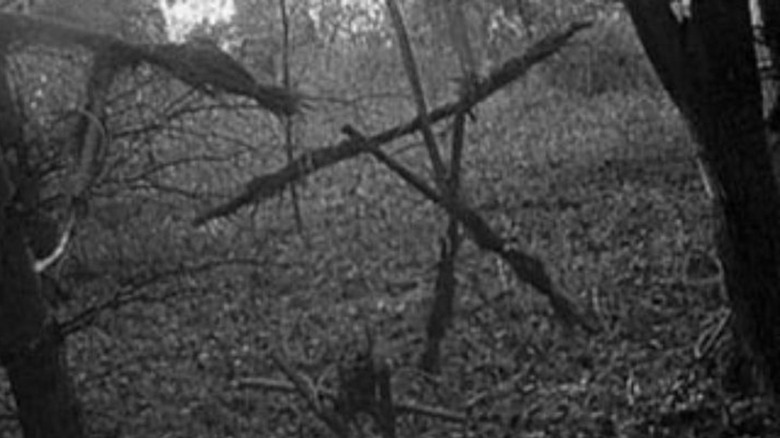Questionable Things That Happened In The Blair Witch Project
"The Blair Witch Project" is one of the most celebrated horror movies of all time. Its impact on horror in the 21st century, and especially the boom of found footage horror, is undeniable. And beyond its influence on other projects, it spawned a franchise — made up of films, novels, comics, TV specials, and video games. The woods outside Burkittsville, Maryland have kept people interested and actively engaged in its mysteries for more than two decades now, so there's no questioning the original film's popularity or importance.
However, there are a good amount of questions that might arise when revisiting the movie that started the found footage craze almost twenty years after "Cannibal Holocaust" introduced the idea into film. We won't be questioning the veracity of the film, as hopefully that question has been well laid to rest by now — but even without that one big question, here are several things that are questionable that happened in "The Blair Witch Project."
Constant arguing about filming takes you out of the movie
As with any found footage movie, it's important that there be enough footage to create a feature length film from the "raw" footage, and that footage is capable of telling a story. As with many of the found footage horror movies that followed, the protagonists of "The Blair Witch Project" are filmmakers who want to make a documentary about a spooky phenomenon. It's a simple and obvious set up that's worked many times.
But it becomes questionable when it feels like nearly every scene includes an argument about filming. It only calls attention to the fact that people in this situation should have given up on filming to focused on survival. It's one thing to have characters continue filming throughout a found footage movie, and another to draw attention to the fact that they shouldn't be. The arguing about filming in "The Blair Witch Project" makes sense, as anyone in these situations would object to filming, but it doesn't actually help add to the realism at all. Instead, this arguing takes us out of the experience of the movie to remind us that we're watching a movie from the safety of a theater or our home.
Never deciding to follow the river
As the film goes on, and the group struggles to get out of the woods after losing their map, they decide to follow it a single direction on their compass until they make it out of the woods. It's a good idea because, as they say a number of times in the movie, the woods are not that big and it's hard to get lost in nature anymore. But after their path simply brings them back to the same river that they crossed hours earlier, one has to question why their next instinct is to pick a different direction on the compass.
At least one of the characters believes that something supernatural may be going on, so it's easy to imagine that the titular witch might manipulating the compass through her occult powers. This would make it not just useless to our protagonists, but instead a tool that can be used to keep them in the woods. But besides the compass, the trio fully ignores the other potential solution that's right in front of them: the river. It may not be known that following a river downstream is a recommended way to find your way back to civilization, but one has to question why the group of students in "The Blair Witch Project" doesn't even consider the option of using the river to guide them out of the woods.
What's in the bundle of sticks?
After Josh disappears and the students hear what sounds like him shrieking in pain, Heather and Mike find a bundle of sticks outside their tent the next morning. Heather throws the bundle of sticks away in fright at first, but her curiosity gets the better of her and she opens the bundle to find some things that really scare her, making her scream and gag.
But what's in the bundle? It's almost impossible to make out anything except for some hair, which looks black in contrast to Josh's light brown to blond hair. And while there seems to be a pool of blood, the grainy photography and chaotic camerawork make it difficult to see what might be in that pool. It's easy enough to find answers online about what's in the bundle, but it makes for a somewhat frustrating experience while watching. Instead of building the horror of the scene, the fact that we can barely make out any of the items (and aren't offered clarification by any dialogue) makes for a confusing moment that just leaves us without answers to a very easily answered question.
Making the most insufferable character the only woman
There are no gender constraints on which characters can be insufferable in movies and TV, but it becomes a bit questionable when only one of the three characters in your movie is a woman — and she's the only one that the audience comes out of the movie hating. Heather is arrogant and insistent in the face of real danger that the group continue shooting more footage for her documentary, which the actor has acknowledged to GQ did not endear her to audiences.
This wouldn't be an issue if the characteristics that make Heather a nightmare were transposed to one of the two men, or if another member of the group, or even all three of the characters were women. Compare this to fellow found footage movie "As Above So Below," which has an unbearably annoying and self centered female lead — but also includes another woman in the group.
It's not a major problem in "The Blair Witch Project," but it does seem questionable that the worst character in the film is the only woman of any significance.
A woman in charge leads people to die
Adding to the issue of Heather being the only woman in the group and being the most aggressively off putting, is the fact that this is Heather's project. An undeniably unfair but nonetheless accurate summary of the film could be "a woman tries to direct a movie and gets herself and the crew killed in the process." The concept of an arrogant and naïve director leading a crew into a situation where they all die is classic found footage stuff. But it's the fact that only one of the three leads in "The Blair Witch Project" is a woman who leads these men to their death that raises eyebrows.
This issue could have been easily fixed: just add more women to the group. In "The Descent," it's entirely a woman's fault that the group of spelunkers ends up in an uncharted cave network inhabited by flesh hungry monsters — but it doesn't feel like a comment on anyone's gender as every single character in the film is a woman.
Too many stories means there isn't one that's more impactful
Before the filmmaking crew go into the woods, they do their best to gather stories of the witch from the locals who live near the woods in Burkittsville. But instead of offering stories that build on and corroborate one another, the stories are all disparate and could function as the premises for their own individual horror movies.
The crew learns about serial killer Rustin Parr, who in the early 1940s took children to his home in the woods to kill them in his basement. They're told of a young woman named Robin Weaver, who went missing in the late 1800s but returned three days later telling of a woman whose feet never touched the ground. They speak to a woman who saw the witch in the form of a human and animal hybrid. And through their own research, the crew learns of a group of men who were bound and tortured at the edge of the woods before disappearing without a trace.
These are all genuinely unnerving stories that could be developed into solid scary movies on their own, but the fact that there are so many of them in one movie that never explains itself leaves "The Blair Witch Project" feeling more confusing than scary.
Doesn't quite make the ambiguity work
There's a reason so many horror movies have mystery plots: the unknown is fundamentally scary. We want to understand things in general, and we especially want to understand things like who is harming us and why they're doing so. There are a number of successful horror movies that never answer their central questions — from "Black Christmas" (1974) never revealing Billy's identity, to the entire cosmic horror subgenre drawing from things beyond human comprehension — but "The Blair Witch Project" isn't one of them.
Because the film includes so many different spooky stories, it's impossible to know exactly who or what was attacking them and ultimately killed them of course — but it's also impossible to decide which unknown to be scared of. Instead of this ambiguity leaving a sense of vague dread, it mostly just leaves us confused about what has happened. Instead of questioning our safety, we end up questioning why there were so many different options for an explanation.
Who is editing?
The "who is editing?" question plagues a number of found footage horror films, but at least some of them do better with only filming when it makes sense so the cuts appear when the filming starts and stops. "The Blair Witch Project," on the other hand, reminds us often that Heather is filming at almost all times with two cameras, and the opening text simply states that their footage was "found."
These issues really raise the question of who edited the film together. More specifically, who removed what must have been hours of superfluous content and made the decisions to cut between cameras? This question could have easily been addressed by making the opening text a little less snappy and adding "it is presented here in an edited narrative form." The editing question is just another that ends up straining credulity and pulling the audience out of the film.
Switching between two cameras
There are found footage movies about friends going on a trip and encountering something, and there are found footage movies about people trying to make a movie — both are equally valid entries in the subgenre. "The Blair Witch Project" runs into some questionable territory by attempting to be both. The crew have a 16mm camera that they've rented from their school, and Heather carries a camcorder with her to document their filmmaking journey.
It makes sense where's two cameras, but they lead to some other questions — specifically, why is there constant arguing about filming and who is editing? The fact that there is a more professional camera allows Heather to shout about how she wants to "get this on 16," again drawing attention to the fact that we are watching a purposefully constructed movie. And the (undeniably well done) editing between the cameras draws attention to itself every time the movie switches from color to black and white.
Making fun of a mentally ill or just odd person
When the trio is interviewing people in Burkittsville, they set up an interview with Mary Brown, an older woman who carries herself a bit oddly. It's possible that Mary has mental illness, or is just a bit of an odd person who moves and speaks somewhat differently. But either way, there's nothing she does to deserve the mockery and seeming vitriol of the group, and especially Heather.
During Mary Brown's interview, Heather repeatedly interrupts her, sometimes even contradicting what Mary is attempting to say before Mary finishes her sentences. It's a frustrating interview to watch, if only because we as the audience want to hear what this woman has to say, but Heather keeps speaking over her. But it's after the interview that the true questionable conduct begins — all three of the students seem to agree that Mary is "crazy" and make fun of her mannerisms and story. It's upsetting to watch and doesn't help endear these people to the audience at all.
The night time, day time story structure gets repetitive
Once the trio has completed their interviews and made it into the woods, "The Blair Witch Project" should build on the horror of the tales we've heard. Any story should gain momentum until reaching a climax. Sure, some stories are made up of vignettes that contribute to a larger theme, but most of the best horror movies (especially those with mysteries at their core) build tension and horror until they come to a head.
"The Blair Witch Project" certainly has a finale, when Mike and Heather arrive at the home in the woods. Even so, the film doesn't really gain any momentum throughout its runtime that leads us to that finale, because its story structure is too repetitive. Every night something scary happens, and every morning the crew wakes up to find some symbol that they are being watched and purposefully terrorized. It becomes redundant and instead of building the horror, it makes it feel as if the movie is just spinning its wheels to meet a feature length runtime. Combined with the many stories that are set up at the start of the movie, the repetition of the same events makes the movie less scary overall.
No backstory for the stick figures
It's a great image, it's simple, creepy, and inspires the kind of fear that only the best folk horror can: a small group of sticks in a configuration that looks like a person. But what is it? Or at least, where did it come from? Not even literally in the context of who made these, but what is the backstory and origin of the figure?
These are all questions that remain after the end of "The Blair Witch Project." They're all the more frustrating, because the movie includes such a variety of backstories in its first few minutes when the crew interviews the residents of Burkittsville. It feels like any of those conversations could have included a point about the symbol of the witch and how it developed. Really, anything would help to give the undeniably great design some more weight in the movie.
